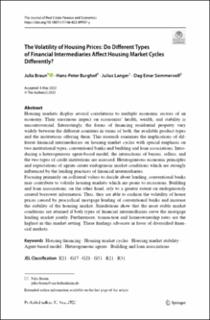| dc.contributor.author | Braun, Julia | |
| dc.contributor.author | Burghof, Hans-Peter | |
| dc.contributor.author | Langer, Julius | |
| dc.contributor.author | Sommervoll, Dag Einar | |
| dc.date.accessioned | 2023-01-20T08:24:07Z | |
| dc.date.available | 2023-01-20T08:24:07Z | |
| dc.date.created | 2022-09-14T07:12:32Z | |
| dc.date.issued | 2022 | |
| dc.identifier.citation | Journal of real estate finance and economics. 2022, . | en_US |
| dc.identifier.issn | 0895-5638 | |
| dc.identifier.uri | https://hdl.handle.net/11250/3044796 | |
| dc.description.abstract | Housing markets display several correlations to multiple economic sectors of an economy. Their enormous impact on economies’ health, wealth, and stability is uncontroversial. Interestingly, the forms of financing residential property vary widely between the different countries in terms of both, the available product types and the institutions offering them. This research examines the implications of different financial intermediaries on housing market cycles with special emphasis on two institutional types, conventional banks and building and loan associations. Introducing a heterogeneous agent-based model, the interactions of buyers, sellers, and the two types of credit institutions are assessed. Heterogeneous economic principles and expectations of agents create endogenous market conditions which are strongly influenced by the lending practices of financial intermediaries.
Focusing primarily on collateral values to decide about lending, conventional banks may contribute to volatile housing markets which are prone to recessions. Building and loan associations, on the other hand, rely to a greater extent on endogenously created borrower information. Thus, they are able to cushion the volatility of house prices caused by procyclical mortgage lending of conventional banks and increase the stability of the housing market. Simulations show that the most stable market conditions are attained if both types of financial intermediaries serve the mortgage lending market jointly. Furthermore, transaction and homeownership rates are the highest in this market setting. These findings advocate in favor of diversified financial markets. | en_US |
| dc.language.iso | eng | en_US |
| dc.publisher | Springer | en_US |
| dc.rights | Navngivelse 4.0 Internasjonal | * |
| dc.rights.uri | http://creativecommons.org/licenses/by/4.0/deed.no | * |
| dc.title | The Volatility of Housing Prices: Do Different Types of Financial Intermediaries Affect Housing Market Cycles Differently? | en_US |
| dc.title.alternative | The Volatility of Housing Prices: Do Different Types of Financial Intermediaries Affect Housing Market Cycles Differently? | en_US |
| dc.type | Peer reviewed | en_US |
| dc.type | Journal article | en_US |
| dc.description.version | publishedVersion | en_US |
| dc.source.pagenumber | 32 | en_US |
| dc.source.journal | Journal of real estate finance and economics | en_US |
| dc.identifier.doi | 10.1007/s11146-022-09907-y | |
| dc.identifier.cristin | 2051463 | |
| cristin.ispublished | true | |
| cristin.fulltext | original | |
| cristin.qualitycode | 1 | |

